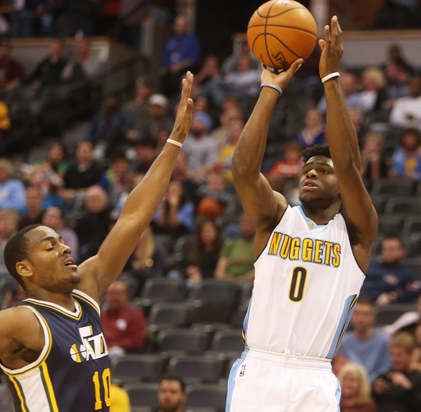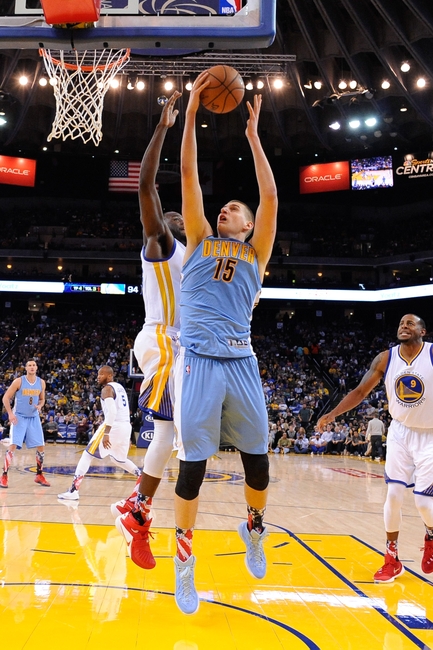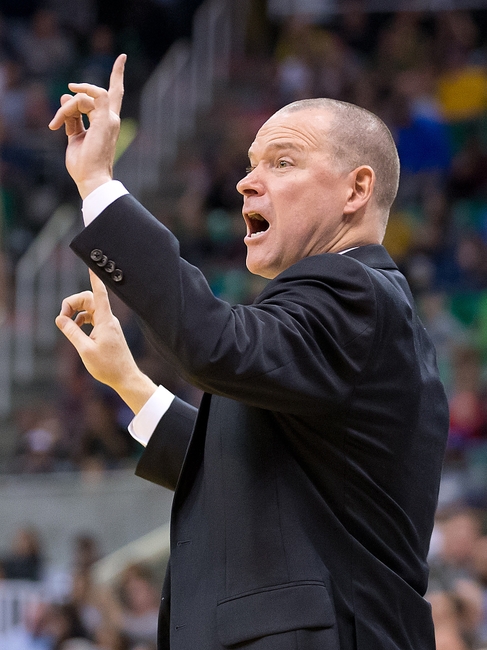© 2025 ALLCITY Network Inc.
All rights reserved.

Welcome to the League, Kid
I noted in my first time writing in this space that this season would bring some good, some bad, and some ugly for Emmanuel Mudiay. So it goes for 19-year-old point guards that get the starting nod in the NBA. At least once a game the kid throws a pass that makes my 3-year-old wonder why I am making weird noises and jumping out of my recliner. There have been at least two or three passes I can remember off the top of my head this season that looked like they had been thrown by Magic Johnson’s somewhat shorter clone.
However, there have also been moments where Mudiay is far too loose with his handle and tries to force a play that isn’t there. These kinds of moments can only be reduced through experience and the wisdom that comes as a result. I have no doubt these instances of youth will happen with decreasing frequency even in March and April of this season let alone two or three seasons down the road.
The issue that worries me most thus far is his shooting ability. We knew this was a concern going into the draft, but now a month into his rookie season we have a unique set of qualitative data in the NBA as opposed to just quantitative data from the past. I believe shooting is the biggest issue because it’s a matter of technique rather than experience, and if it doesn’t get corrected soon, it will likely never change.
There have been at least two or three passes I can remember off the top of my head this season that looked like they had been thrown by Magic Johnson’s somewhat shorter clone.
The first issue is that Mudiay fades away on his shot when he doesn’t need to. Interestingly, on the Altitude broadcast against the Mavericks last Saturday they showed footage from Mudiay playing in high school. The one jump shot they showed? You guessed it. He was fading away from about 15-feet when he could have shot a regular jump shot. The kid needs to learn just how big and strong he is. There is no reason for him to be fading on a pull-up jumper in the lane. If he truly needs to fade than the shot he’s taking isn’t a good one.

The second problem with Mudiay’s shot is that he often shoots the ball on the way down. An optimal jump shot has its release point at the apex of the player’s jump. Sometimes this happens for Mudiay. At other times, though, he hangs and then releases on his way down. Perhaps he does this to try and compensate for his average leaping ability, but the problem is it dramatically decreases the chances of him making the shot.
The final concern with Mudiay’s shot is he doesn’t shoot the same way every time. Sometimes when he shoots the three-ball he sort of does this extra kick with his feet. It’s almost as if he’s trying to give the shot a little extra power perhaps because he’s afraid it won’t quite get there. In contrast, there was a three-point shot he took in the first quarter of the game against Dallas where he was wide-open and performed what was basically a set-shot. Great shooters shoot the ball the same way every time regardless of where they are on the court.
Sometimes players get these idiosyncratic ways of playing or shooting almost hardcoded into their basketball DNA. It’s possible to break them, but the earlier the better. These three issues are ones the Nuggets’ staff needs to start working on with Mudiay as soon as possible (and hopefully they already are). If you go back to Tony Parker’s rookie year he shot the ball very differently from 3-point range than he did from mid-range. By his third year in the league he looked like a totally different shooter. However, this happened as a result of good player development coaches working with Parker on building new shooting habits daily for a period of a couple of years. The same can and must be done with Mudiay.
A Long Career For Jokic?
If you are a die-hard Nuggets’ fan it has been hard to miss the early season play of Nikola Jokic. However, if you are a national fan or media member, save one great statistical game against the Spurs, it could be hard to notice him much at all. And in fairness, he’s not exactly the type of player who is going to get quick attention in this Vine, do something that makes my head spin in six seconds kind of culture in which we currently reside. For the Nuggets, though, this isn’t necessarily bad news as they can bring him along slowly with perhaps less pressure than a more bombastic player has applied to him.
When I watch Jokic play I see a little bit of Arvydas Sabonis. Granted, I’m thinking of the late career Sabonis who finished his hooping days as a member of the NBA’s Portland Trail Blazers (with a couple of one year stops at Žalgiris Kaunas mixed in). By all accounts, Sabonis was a much better athlete before chronic issues to his lower extremities slowed him down by the time he made it to the Association. The similarities I see between the two are great skill and trickiness in the block, outstanding vision, and the ability to stretch the floor with the jumper. It’s rare today to have a big who can play effectively both facing and with his back to the basket. Jokic can do both at the tender young age of 20.
I recall a conversation I had with Antonio McDyess a few years back. He told me about how during his second stint with the Nuggets in the early 2000’s his good friend and teammate George McCloud used to tease him about having no clue how to play basketball but noted that he could get away with it because he was a freakish athlete.

Of course, everyone wants a great athlete who is also smart and tremendously skilled. These days in the NBA it seems that many teams opt for the tremendous athlete with the hope that they can help bring along the other two characteristics somewhere around the bend. The old line here is, “You can’t teach athleticism.” While this is true, if I’m forced to choose two of the three qualities I will take skill and basketball I.Q. every time. There have been so many great athletes who have fizzled out in the NBA. Moreover, athletic ability will begin to depart as a player ages north of 30. Great skill can allow a player to play much longer.
I recall a conversation I had with Antonio McDyess a few years back. He told me about how during his second stint with the Nuggets in the early 2000’s his good friend and teammate George McCloud used to tease him about having no clue how to play basketball but noted that he could get away with it because he was a freakish athlete. He told McDyess that when his legs started to lose some spring, that’s when he would start to learn how to truly play the game. Antonio told me he used to just roll his eyes at McCloud. I had this conversation with McDyess near the end of his career in 2009 when he was a member of the San Antonio Spurs, and now McDyess was rolling his eyes at himself wondering how he could have been so foolish. In this way, it’s actually harder for players like McDyess because they have to reinvent themselves later in their careers, something that he was eventually successful at doing. It also demonstrates how one can teach knowledge but not wisdom.
For Jokic, he will always be a below the rim player and already knows how to play effectively as one. He will likely be able to play much the same way well into his 30’s barring catastrophic injury. I don’t know if he will be an NBA All-Star (although it wouldn’t surprise me if he ascended to that level), but I do know that the Nuggets have a second round pick on the roster that could have a career which spans at least a decade. It’s hard to do much better than that with a guy drafted 41st overall.
The Timeout Game
During my time working in the league I found it useful to scout coaches just as players are often scouted and to write it down in a systematic fashion. This can be a good way to help locate a young assistant coach who might be able to make the jump to the head seat. This was not something I was particularly in tune with prior to consulting in the league. Of course I looked at head coaches and their tendencies, but scouting their strengths and weaknesses was a new way of looking at things for me.

One game within the game that I’ve always found fascinating is the use of timeouts. Veteran coaches coaching veteran teams tend to have long leashes. Phil Jackson was always famous for letting his teams play through miserable stretches. It was a kind of experiential learning the Zen Master loved. Of course, if you watched Phil coach earlier in his career, he often had a much quicker trigger. Somehow winning multiple titles buys a coach some clout or “juice” to engage in these kinds of experiments that a young coach believes he just can’t afford.
With Michael Malone I’ve noticed he will call timeouts very quickly. I’ve seen him use up most of his allotment within the first eight minutes of a quarter at times this season. I’ve also seen him call two timeouts within just a couple of minutes of one another. Often one of these is a 20-second timeout where he is trying to correct something he doesn’t like right after it happens. In many ways this is basic Skinnerian conditioning. When something happens you like, praise as soon as possible. When punishment is necessary, do so right after the adverse behavior occurs and be specific with regard to why it’s happening. There are, of course, pros and cons with any approach, but I think the one Malone is taking with this young Nuggets’ team is a smart one.
The Upside of Conflict
Chances are if you’re reading this right now you are already well aware of the little incident that happened between Malone and Mudiay last week where the two exchanged words. I have already been asked by more people than I can count, at least with my socks still on, for my thoughts. My initial thought was it’s a complete non-issue. After I saw the video of it, I felt even more strongly that it was much ado about nothing.
I have seen those kinds of exchanges literally hundreds of times as a player, coach, or scout at the high school, college and professional levels. Heck, neither guy even got up from his chair. I’ve seen towels thrown, bodies restrained, and hurt feelings that persisted weeks or even months into the future. What was different, though, was the way both guys handled it afterwards.
Just a few minutes after the incident occurred Mudiay was in the locker room already taking responsibility for his actions. When it happens this quickly, you know the sentiment is genuine because the media relations staff doesn’t really have time to coach him up on what to say. Usually what happens is the next the day the player half-heartedly says something that you can tell he was instructed to say but doesn’t really mean. This was not the case with Mudiay.
I was equally impressed by the way Malone dealt with it. He said he apologized to the team for his actions and also issued a vehement public apology. In other words, Malone approached the situation with some humility and didn’t let his ego get in the way of what was best for his coaching staff and his team.
Trust me, players are taking note when these kinds of things happen. Does the coach kick the 19-year-old rookie under the bus in the media when things start going south? Is he more focused on making himself look good rather than doing what’s right for the team? You might be surprised how quickly an incident like this can take a team to edge of the cliff that DeMarcus Cousins and George Karl pushed the Sacramento Kings to this past summer. On the other hand, when any family can effectively negotiate conflict, it ultimately increases trust and commitment.
Comments
Share your thoughts
Join the conversation



